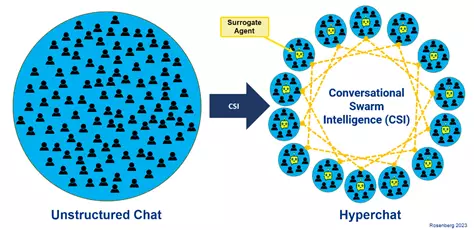In an age where teamwork and collaboration are paramount to success, the conventional methods of brainstorming and decision-making are becoming increasingly inadequate. Traditional group dynamics often falter when it comes to larger teams. Studies consistently show that optimal group sizes for meaningful exchanges are usually limited to just a handful of participants — typically four to seven people. Beyond this threshold, conversations can quickly devolve into chaos, where individual voices become lost amidst a cacophony of opinions and ideas. However, a new frontier has emerged with the advent of generative AI technology known as hyperchat, which proposes to transform this area by allowing expansive groups to engage in structured, real-time discussions.
How Hyperchat Works
Hyperchat fundamentally redefines how large teams can collaborate. By dissecting vast groups into smaller, manageable subgroups, each facilitated by an AI agent termed a “conversational surrogate,” hyperchat fosters efficient communication. These surrogates manage the flow of dialogue, distilling insights from local discussions and sharing relevant information with the wider group. This structure not only enhances interaction but also amplifies collective intelligence, making it feasible for teams of hundreds to converge on consensus-driven outcomes in real time.
The implications of this are profound. With technology like hyperchat, any organization can gather diverse perspectives and funnel them into a singular, intelligent decision-making process. The staggering potential is further validated through experiments conducted by Unanimous AI, where groups of random individuals utilize hyperchat to complete complex tasks far beyond what is achievable through traditional methods.
Real-World Applications of Hyperchat
One remarkable demonstration of hyperchat’s capabilities was a competition initiated by Unanimous AI, where 50 sports enthusiasts were tasked with creating a March Madness bracket through this new technology. When evaluated against millions of other submissions in ESPN’s contest, the hyperchat-generated bracket surprisingly soared to the 99th percentile. This striking performance not only affirms the efficiency of hyperchat but also highlights its ability to harness collective intelligence effectively.
Furthermore, multiple studies lend credence to hyperchat’s extraordinary potential. A collaborative research effort with Carnegie Mellon revealed that when groups of 35 were asked to take IQ tests in hyperchat, their collective score surged to an effective IQ of 128, pushing them into the realm of gifted intelligence. Another project sought to assess brainstorming sessions with and without hyperchat, revealing that participants reported higher levels of productivity and satisfaction when engaging via the platform, affirming that hyperchat leads to superior results.
A New Paradigm: Hybrid Collective Superintelligence
Perhaps even more groundbreaking is hyperchat’s ability to meld human insight with AI capabilities to form a hybrid collective superintelligence. The introduction of a second AI agent, the “contributor agent,” enables real-time fact-checking and information dissemination during discussions, providing essential contextual support to human participants. This dual-agent structure facilitates a rich dialogue between humans and AI, ensuring that decisions made are not only informed by diverse perspectives but also grounded in factual accuracy.
The transformative power of this technology becomes increasingly evident in sectors that require critical decision-making. In aspects like business strategy, product development, and resource allocation, the ability to convene large teams efficiently is invaluable. With leading corporations employing tens of thousands of individuals, hyperchat offers a solution to the bottlenecks that typically impede large-scale collaboration, fundamentally shifting how organizations approach collective decision-making.
A Future Driven by Collective Intelligence
As we continue to push the boundaries of collaboration in our increasingly complex environments, the implications of hyperchat technology cannot be understated. It not only promises to reshape the nature of teamwork but also invites organizations to rethink how they integrate human creativity and AI capabilities. In a world where knowledge can be fragmented and voices drowned out, hyperchat emerges as a beacon of hope, demonstrating that even large groups of individuals can think smarter together.
While the March Madness tournament unfolds and the collective efforts of 50 sports fans ripple through the ranks of millions, it serves as a real-life testament to what hyperchat can achieve. This technology epitomizes the promise of the future — one characterized by collaborative intelligence that leverages the strengths of both people and machines, driving us toward breakthrough innovations and unprecedented successes. Hence, one must contemplate: in this age of hyper-intelligence, how will organizations harness this potential to sustain competitive advantages in a rapidly evolving landscape?


Leave a Reply